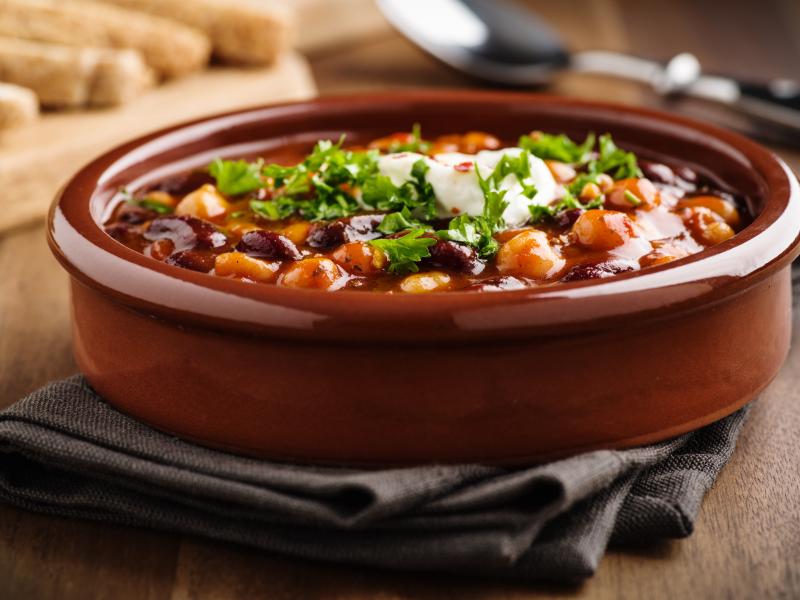
Spicy Vegetarian Chili
Macros / Serving Size
Protein 16g | Fat 10g | Carbs 6 g
% Calories of Macros / Serving Size
Calories 388 | Protein 17% | Fat 22% | Carbs 61%
Nutrients / Serving Size
Fiber 22 g | Sodium 933mg | Sat. Fat 2g
Ingredients (Servings 4)
- 2- 14-15 oz. cans of petite diced tomatoes, no salt added (low sodium preferred)
- ½ cup canned jalapenos
- 2- 15-16 oz can of low sodium kidney beans
- 12 oz. of vegetable broth (low sodium), dark ale, or water
- 8 oz. can of chipotle chilis
- 2 tbsp. olive oil
- 1 large onion, diced
- 1 large carrot diced
- 1 large red pepper, diced
- 1 dash salt
- 3 cloves garlic minced
- 1 ½ tbsp. chili powder
- 2 tsp. paprika
- 1 tsp. black pepper
- 2 bay leaves
- 1 tsp. cumin
- ½ tsp. dark cocoa powder (optional)
- Nonfat Greek yogurt (optional)
Directions
In a large pot, bring to temperature over medium-high heat the olive oil and add the onions, peppers, and carrots. Cook until the onions begin to become tender. Add the salt. Cook for an additional 5 minutes until the peppers and carrots begin to soften.
Add a bit of the liquid of choice and scrape to the pan release the browning that occurred while cooking the vegetables. Continue cooking until the vegetables are fork tender adding liquid as needed. Add spices and the remaining ingredients. Bring all ingredients to a gentle boil, turn heat down to low, cover and let simmer, stirring occasionally for 20-30 minutes.
Serve 1/4th in a deep bowl. If desired, top with a dollop of nonfat plain Greek Yogurt and fresh chives.
Nutrition Education
Nutrients, fiber, vitamins, minerals, fat, protein, carbohydrates, polyphenols, kilocalories, etc. are random terms related to food and diet. Each term has more, articles, expert podcasts, and social media influence dialog than any person could ever “digest”. In the end, it is not that complicated to nourish the body to promote optimal health while lowering the risk of disease and assuring children thrive in growing.
When nutrients are studied, the purpose is to assess what benefit or burden that occurs when too little or too much is consumed and/or what impact they have on a disease state. For healthy Americans that do not have a chronic disease and/or those that are obese without a medical diagnosis, the simple, quick answer is to eat a variety of foods from all food groups in correct proportions while keeping overall calories in balance and limiting the number of calories from empty calories. It is that simple.
The best strategy in doing this is to not only take control of the choices of foods consumed but also in how the food is prepared. This is accomplished by cooking and preparing more meals at home and this starts with being and informed shopper.
Cooking for many is thought of as a burden either due to time or skill. Changing this perspective is key. The time needed to order take-out and/or the burden of thinking every day what drive through one will visit can be refocused to menu planning, shopping lists, and meal preparation. Processed foods are not off limits, especially, when chosen using an informed eyed, like the commissary’s dietitian approved thumbs up tag. Making this a family affair, especially if you have kids will assist in developing the next generations of adults into being totally in control of the foods they consume and their nutrition intake.
Dietitian Tip
Spend 1.5 hours on the weekend preparing some of the meals for the week. Choose one or two meats and use them in a variety of dishes. Freeze the ones for later in the week.
